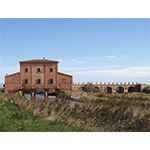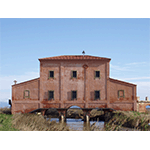Museo Multimediale - Casa Rossa Ximenes [Ximenes House - "Casa Rossa" Multimedia Museum]
This impressive structure, also known as Casa Rossa (red house), was built around 1765 on a project by the Jesuit Leonardo Ximenes, instructed by Grand Duke Peter Leopold of Lorraine to attend to the reclamation project of the Maremma area of the province of Grosseto. Ximenes’ projects marked one of the most important phases in the works of reclamation. The scientist argued that it was not necessary to completely drain the lake of Castiglione, as had been previously attempted, but that its regimen had to be properly controlled so as to avoid stagnation, allowing it to continue to be an important source of income and occupation (fishing, hunting, transport, utilisation of swamp vegetation).
Casa Rossa is a fine evocation of Ximenes’ commitment in the attempt to reclaim the area. Above the three large arches that characterise the structure, the large hoist room housed the machines and pulleys used to manoeuvre the floodgates, the middle one of which weighs about 40 quintals (4000 kilograms). The structure made it possible to control the outflow of the large canal known as the Canale Reale or Maestro, which permitted the exchange of the lake waters. This infrastructure served hydraulic and sanitary purposes, to drive mills and presses, water livestock, assure canal practicability and permit the rational exploitation of fishing, thereby permitting the lake to reclaim its old role as the centre of fish supplies for the grand duchy of Tuscany.
Still in good repair, the building houses the fascinating "Casa Rossa Ximenes" Multimedia Museum, which constitutes the entrance gate to the Castiglione della Pescaia Swamp ("Diaccia Botrona" Provincial Nature Reserve), one of the most important marshlands in Europe. The multimedia itinerary permits, among other things, the live observation of the animals in the area, thanks to television cameras activated from technological stations that reproduce images on large screens.
****************************
Texts by Graziano Magrini
English translation by Victor Beard
Last update 12/mar/2008





